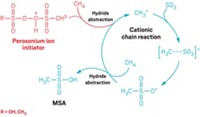Advertisement
Grab your lab coat. Let's get started
Welcome!
Welcome!
Create an account below to get 6 C&EN articles per month, receive newsletters and more - all free.
It seems this is your first time logging in online. Please enter the following information to continue.
As an ACS member you automatically get access to this site. All we need is few more details to create your reading experience.
Not you? Sign in with a different account.
Not you? Sign in with a different account.
ERROR 1
ERROR 1
ERROR 2
ERROR 2
ERROR 2
ERROR 2
ERROR 2
Password and Confirm password must match.
If you have an ACS member number, please enter it here so we can link this account to your membership. (optional)
ERROR 2
ACS values your privacy. By submitting your information, you are gaining access to C&EN and subscribing to our weekly newsletter. We use the information you provide to make your reading experience better, and we will never sell your data to third party members.
Process Chemistry
A greener path toward vanillin from paper pulp
A new electrocatalytic process makes vanilla’s main flavor compound from kraft lignin
by Fernando Gomollón-Bel, special to C&EN
May 14, 2020
| A version of this story appeared in
Volume 98, Issue 19
Vanillin is one of the world’s most popular aroma chemicals and fragrances. However, 85% of it is synthesized from petrochemical precursors, and the food chemical industry is eager to find more sustainable sources. Researchers have now developed an electrochemical method to obtain vanillin from lignin, a tough biopolymer that is a by-product of the paper industry (ACS Sustainable Chem. Eng. 2020, DOI: 10.1021/acssuschemeng.0c00162).
Lignin, left over after cellulose fibers are removed from wood to make paper, contains a mix of aromatic compounds that chemists have found ways to transform into a range of useful products. In the new study, Siegfried R. Waldvogel of Johannes Gutenberg University Mainz and colleagues created vanillin via a simple reaction. They first dissolved lignin and caustic soda in water and heated the solution. Next, they applied an electric current to the high pH solution using inexpensive nickel electrodes, breaking down the lignin and oxidizing it to produce vanillin in yields of up to 4.7%. “This may not seem impressive, but it is a remarkable selectivity,” Waldvogel says. No toxic or noxious side products are produced.
Scandinavian company Borregaard already produces vanillin commercially from lignin via a copper-catalyzed oxidation. However, the process requires high temperature and pressure, and costly purification steps to remove the catalyst, Waldvogel says. Also, it uses a more specialized lignin raw material, whereas the new approach uses lignin from the kraft process, which yields 90% of the world’s paper pulp. About 150 million t of kraft lignin is generated per year, Waldvogel says, making it the most widely available carbon-based material after crude oil.
“This process is greener than currently available alternatives,” says Pablo Ortiz, a process chemist specializing in sustainable development at VITO, the Flemish Institute for Technological Research. Moreover, he values the use of kraft lignin as starting material. “Potentially, this method has the possibility to give higher yields of vanillin than Borregaard’s,” which is 0.3% by weight overall.
Waldvogel’s team has a new grant from the European Commission to build a pilot plant for continuous vanillin production at larger scale. The researchers would eventually like to use crude kraft lignin directly from the pulping process—a basic raw material known as black liquor—to reduce the need for caustic soda and water.





Join the conversation
Contact the reporter
Submit a Letter to the Editor for publication
Engage with us on Twitter